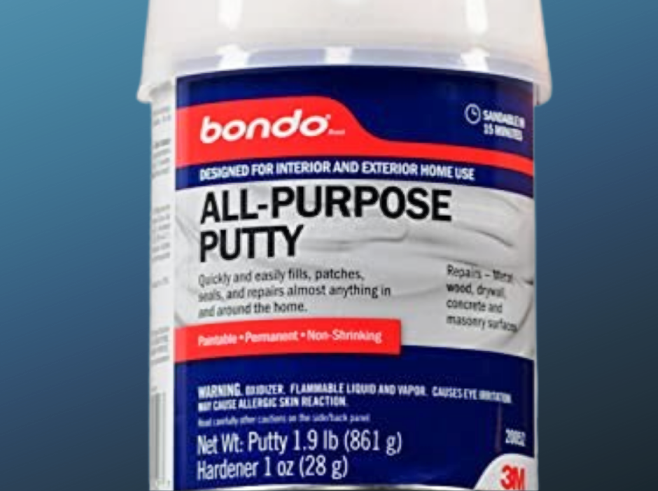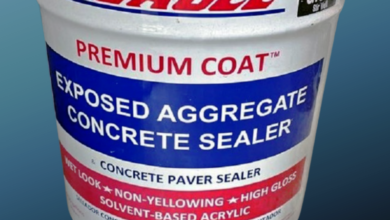Bondo for Concrete Cracks

Concrete is prone to cracking. Concrete surfaces will always develop cracks, no matter how careful you are. You can take action by learning how to fix these cracks as soon as they appear.
These days, Bondo is primarily connected to auto repairs. However, did you know that it can also be applied to other materials like concrete, stone, fiberglass, aluminum, and wood?
I’ll be walking you through the steps of using Bondo to fix concrete today. I’ll also leave you with some advice and substitute techniques for sealing concrete cracks.
Is Bondo Acceptable for Cracks in Concrete?
It is possible to fix minor cracks in concrete with Bondo. The tiny cracks in your concrete can be filled in as it dries with this two-part epoxy putty.
Bondo sticks to concrete just as well as it does to metal. I adore Bondo because it can be painted to blend in with the concrete’s current finish. Thus, in addition to filling in cracks, it can improve the appearance of your concrete walls or floors.
How Can Concrete Crack Repair Be Done With Bondo?
Using bondo to seal concrete cracks is a reasonably simple procedure. This is a professional-approved, step-by-step guide;
- Step 1: Give the concrete crack a thorough cleaning
The amount of dirt and impurities in the crack may vary depending on how long it has been there. The adherence of bondo to concrete may be impacted by the existence of such impurities.
Apply a high-pressure water spray to the cracks first. That will get rid of loose concrete and dirt particles. Give your concrete crack some time to dry before applying Bondo. First, give it time to dry.
- Step 2: Blend the Bondo
Bondo is a two-part epoxy that requires mixing with a hardener. Make sure to follow the manufacturer’s recommended ratios. Bondo may not work well if you use too much hardener, and vice versa.
- Step 3: Use a putty knife to fill the crack with bondo.
With a putty knife in hand, begin packing the Bondo into the crack in the concrete. Bondo should spread easily because, once mixed, it becomes a smooth paste. Make sure it enters the crack as deeply as feasible.
- Step 4: Allow It to Air Dry
Allow enough time for the bondo to dry. How long this takes will depend on the surroundings. The Bondo may take longer to cure if the environment is overly humid.
- Step 5: Retouch the Bondo
You can now touch up the surface to make it look more like concrete after it dries. To improve its appearance, the surface must be painted and sanded. The crack should be fully sealed and fixed with a few touch-ups.
Why Should I Use Bondo to Repair Concrete Cracks?
There are many other products available, as you may already be aware, that can be used to fix concrete cracks. I’ll talk about these options later. But let’s concentrate on the advantages of using bondo to fix concrete cracks for the time being;
- It’s a simple process to apply. It’s evident from the above method that applying Bondo to concrete cracks is not too difficult. No particular abilities, equipment, or knowledge are required.
- Bondo is incredibly robust. A concrete crack filled with Bondo can withstand years of use. Unlike other products, this one is resistant to chipping from the weather.
- When applied to concrete cracks, Bondo dries fairly quickly. Bondo can be used to fill in cracks and then open the affected area for traffic after it dries in a few hours.
- Cracks in concrete surfaces, both inside and outside, can be fixed with Bondo. It is an excellent option for homeowners who have cracks on the inside and outside due to its versatility.
- Bondo is an inexpensive way to fix cracks in concrete. The product bondo itself is not very expensive. The fact that you don’t have to pay a professional to apply it for you also considerably lowers the cost of repairs.
- Bondo can be finished and painted to blend in with the current concrete. This is useful because it makes the repairs appear more attractive.
Does Applying Bondo To Concrete Cracks Have Any Drawbacks?
Unfortunately, bondo has a few disadvantages when it comes to fixing concrete cracks. It’s important to familiarize yourself with these disadvantages.
- Only minor concrete cracks can be repaired with Bobo. Look for other solutions if you have a large crack in the concrete.
- Bondo’s rigidity after drying is the other problem. There are numerous movements in concrete. Bondo is rigid, so excessive movement can cause it to crack.
- Bondo might not stick to your finely polished concrete as well. Use bondo only on rough concrete to ensure enough adhesion.
- Applying Bondo to cracks in concrete is not a permanent fix. In contrast to hiring a professional repair service, Bondo is more of a temporary solution that will wear out in a few years.
In What Way Is Bondo Distinctive From Other Concrete Crack Repair Techniques?
As I previously stated, Bondo isn’t the only product that can be used to fix concrete cracks. There are many alternative products and techniques available. Therefore, the following are the best substitutes for bondo when fixing concrete cracks:
- Injecting Epoxy: If you contact a certified concrete company, they will use this technique to seal the fractures in your concrete flooring.
The procedure involves the injection of epoxy resin into the fissures. This resin has a decades-long shelf life and adheres strongly to concrete.
- Concrete Crack Sealants: Certain sealants are designed specifically to be applied to concrete cracks. These sealants come in polyurethane or silicone varieties. These sealants, in contrast to bondo, can bend to conform to the structural flexural movements of concrete.
- Concrete Patching Compounds: These come in cement, polymer, and latex forms and function similarly to sealants. The superior adherence that concrete patching compounds provide sets them apart.
Each of these approaches has advantages and disadvantages. Take some time to consider which option seems more suitable for you.
A quicker and less expensive way to fix concrete cracks is with bondo. But an epoxy injection is stronger and lasts longer. Sealants, however, provide superior adhesion.
Which kinds of cracks in concrete work well with Bondo?
Not all cracks could be fixed with Bondo. It works best on smaller, shallower cracks that are narrow. Concrete chips, hairline cracks, surface cracks, and non-structural cracks can all be repaired with Bondo. For large cracks, you’ll need to look into expert repair techniques.
How much time does Bondo stay on cracks in concrete?
When applied correctly, bondo epoxy on concrete cracks can last for many years. To underline what I just said, Bondo is extremely resilient and weatherproof. However, you must realize that it is not infallible.
Concrete movements have the potential to enlarge the crack and render the bondo useless. Furthermore, a concrete surface that is subjected to severe weather and heavy traffic will eventually crumble.
Inadequate application is another factor that can reduce Bondo’s longevity on concrete cracks. Premature failure can occur from errors such as improperly preparing the bondo or failing to fill the concrete crack sufficiently.
Consider applying a specific sealant to the concrete cracks to extend the life of Bondo.

